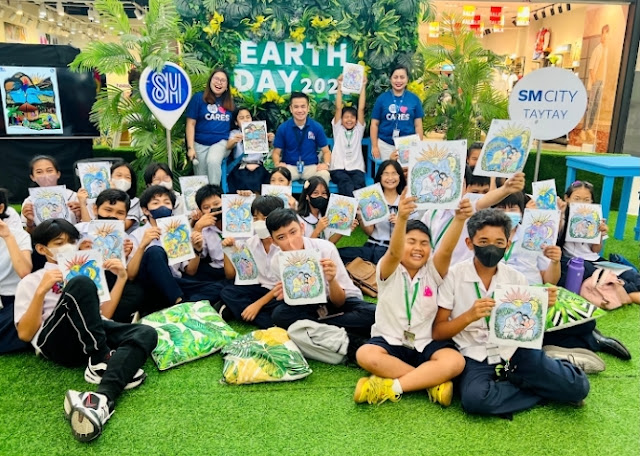1700 children celebrate Earth Day at SM malls nationwide.
SM Supermalls, in collaboration with its corporate social responsibility arm, SM Cares, the Department of Environment and Natural Resources (DENR), local government units and partner schools and organizations joined the rest of the world in celebrating
Earth Day at SM malls nationwide on April 22, 2023.
With the theme "Invest In Our Planet, Invest In Our Youth," SM Supermalls and SM Cares lined up various activities that aimed to raise awareness among children and their families about the importance of coming together across various sectors to take care of the environment. SM malls nationwide simultaneously held relevant and impactful celebrations with activities such as Children’s Storytelling, Coloring, and Sustainability Tours, gathering 1700 children and 350 employee volunteers. These activities aimed to encourage everyone in the family, particularly the young ones, to protect and respect Mother Earth.
Earth Day is an annual celebration led by the Earth Day Network that puts the spotlight on issues that are affecting the environment. First held in 1970, Earth Day was the result of a need for a unified response against various environmental problems like pollution and resource depletion. Today, the event is considered the biggest environmental movement in the world, with millions joining celebrations every year.
Children learn about how to protect the environment individually and as a community through art, storytelling and a Sustainability tour around SM malls
“At SM, every day is Earth Day. However, today we are reminded of our responsibility to protect the planet we live in. We believe that we must all come together and take the necessary steps against this climate crisis and accelerate a greener and more equitable future for everyone,” shared Ms. Liza B. Silerio, SM Supermalls Vice President for Corporate Compliance and SM Cares Program Director for the Environment.
SM Supermalls featured the art of multi-awarded Filipino artist, sculptor and illustrator, Manuel Baldemor. His works depict the rich cultural aspects of the Philippines and can be found in multiple institutions worldwide. His drawings and Earth Day poem inspired the Earth Day program at SM, reflecting a long-time partnership on SM Cares programs for the environment, starting with his design of SM’s first eco bags in 2007.
The storytelling activity featured a special Earth Day story based on Baldemor’s artworks. The story reflected simple ways children can participate in living sustainably on their own and with their families. Meanwhile, kids and kids-at-heart were welcomed at the coloring activity section. Participants were given art materials and a selection of Baldemor's drawings to color in. Malls used recycled materials in designing the activity areas.
And to cap off the celebration, a sustainability tour was held wherein everyone participated in a guided tour to one or more of the mall’s eco-friendly facilities such as the EV charging stations, water recycling treatment plants, waste segregation bins, Plastic Waste Collection booths, E-waste Collection bins and various bicycle amenities.
Filipino artist Manuel Baldemor’s artistic contribution provide inspiration for the Earth Day program. Joining him at SM City Fairview were DENR NCR Director Mr. Manuel T. Escasura; Quezon City Vice Mayor, Honorable Gian Sotto; Ms. Andrea Villaroman, Head of the Quezon City Climate Change and Environmental Sustainability Department, Planet CORA’s Partnerships Director, Cat Trivino and SM Supermall executives.
To highlight the role of collaborating with the public sector in driving environmental programs forward, SM City Fairview hosted the DENR Gawad Taga-ilog Awards photo exhibit, which recognized winning local government units who are leading in protecting Metro Manila’s waterways. The agency also further provided 800 tree seedlings to participants and customers through a DENR Community Pan-TREE to encourage at SM Megamall, SM Mall of Asia, SM North EDSA, SM City Fairview, SM City Novaliches, SM City Marikina, SM City East Ortigas and SM Southmall.
The Quezon City Climate Change and Environmental Sustainability Department also promoted the city’s Trash to Cashback program to encourage its citizens to be Eco Warriors and promote recycling.
Youth participants join forces with SM Supermalls for a sustainable future.
The Earth Day celebration is just one of the numerous ways that SM is promoting sustainable living among Filipinos, and the company has other programs aimed at helping care for the environment. These are the Trash to Cash Recycling Market held every first Friday and Saturday of the month; daily water recycling systems, and environmental campaigns such as the Green Film Festival, Green Retail Agenda, and the International Coastal Cleanup Drive, just to name a few.
SM Cares is the corporate social responsibility arm of SM Prime Holdings, responsible for initiatives that promote sustainability and the development of the community. SM Cares’ advocacies include programs on Women and Breastfeeding Mothers, Persons with Disabilities, Senior Citizens, and Children and Youth, as well as the Bike-Friendly SM initiative, in addition to its Programs on Environment.
To learn more about these, visit www.smsupermalls.com/smcares.
Let's protect our planet, learn how to save and create a domino effect to have
a sustainable and green living
Thank you for reading this article for Earth day.





%20(1).png)

.JPG)
